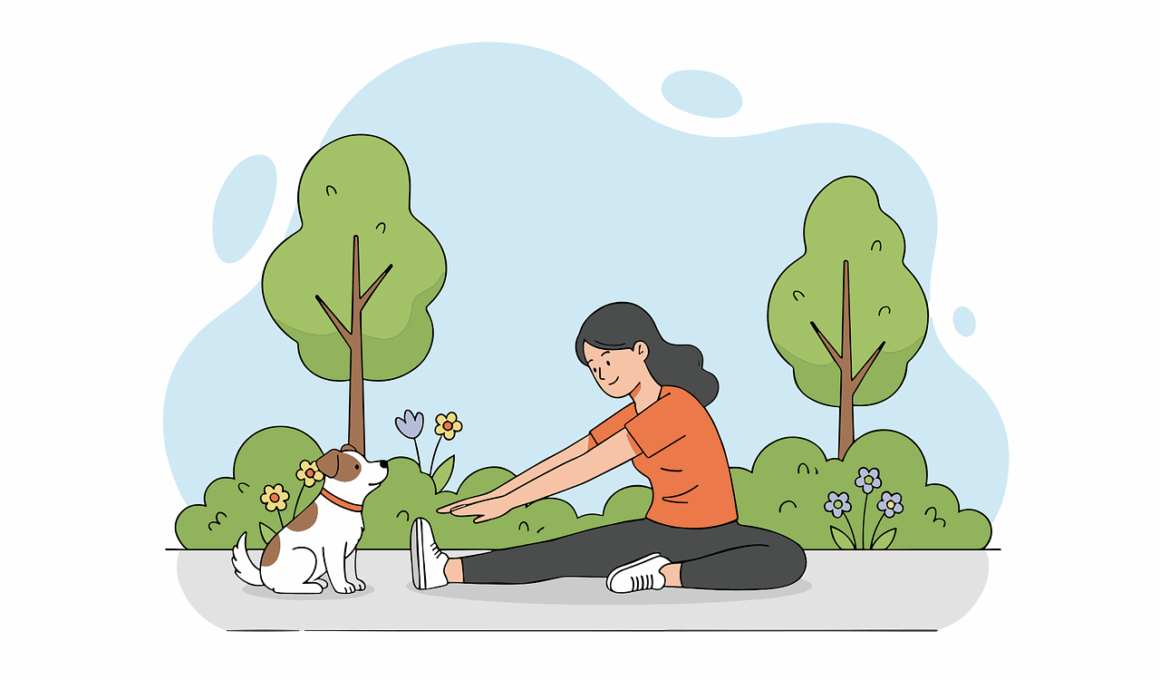Canine Yoga and Stretching: Different Types of Exercises to Try
Canine yoga is an emerging trend that combines mindfulness with physical activity for dogs. This holistic approach to dog exercise emphasizes flexibility, strength, and relaxation, creating a balanced routine that benefits both dogs and their owners. Stretching is vital for maintaining a dog’s overall health, improving their mobility, and helping to prevent injuries. Just like humans, dogs can greatly benefit from a good stretch after exercise. Engaging in canine yoga can also promote bonding between the dog and its owner. Various poses in canine yoga, such as downward dog and upward dog, mimic familiar stretches, allowing dogs to feel more comfortable and relaxed during sessions. Practicing these stretches in a calm environment can ease anxiety and provide both mental and physical wellness for your furry friend. For an enjoyable session, you may need a yoga mat and some space to move freely. Ensure to motivate your dog using treats as rewards during practice. Always observe your dog to identify their comfort levels. Each dog’s ability to participate will depend on their age and fitness level. Adjust the exercises as necessary to accommodate their needs.
One popular practice in canine yoga is the “Paw Pose,” which encourages your dog to stretch out their limbs and loosen their muscles. Begin by having your dog stand with their front paws on a raised surface while their hind legs remain on the ground. This allows them to extend their back and hind legs, promoting strength in those areas. Another effective exercise is called the “Tail Wag Stretch.” You can initiate this by gently encouraging your dog to roll onto their back and wiggle from side to side. This stretch not only relaxes the spine but also engages the core muscles. It’s essential to create a supportive atmosphere during canine yoga sessions, filled with encouragement to make everything feel fun for your dog. Also, be conscious of their reactions throughout the routine, adjusting poses as necessary to avoid discomfort. The duration of each exercise should be short and tailored to your dog’s attention span. Maintaining a positive experience will improve the likelihood of regular engagement in stretching routines. Ultimately, this practice can lead to a happier and healthier lifestyle for your canine companion.
Stretching for Enhanced Flexibility
Flexibility stretching is crucial, particularly if your dog participates in high-energy activities like agility or fetch. A common stretch to incorporate is the “Hamstring Stretch,” which involves encouraging your dog to lay down and stretch their legs out. You can assist your dog by gently placing their back leg under light pressure, ensuring their comfort. This exercise aids in preventing muscle strain. It’s beneficial to intersperse these stretches between play sessions to ensure your dog remains limber. Another important stretch is the “Hip Opener Stretch,” where your dog is coaxed into a lying position, and their legs are spread apart gently. This stretch maintains joint health, vital for dogs of all ages. Implementing regular stretching routines can significantly enhance your dog’s range of motion. To create a structured stretching schedule, consider setting a three-day-a-week plan focused on these flexibility stretches. You will notice improvements in your dog’s playfulness and energy levels over time. Ensure to be patient as your dog gets acclimated to these routines, gradually introducing new stretches as they become more comfortable.
As you explore different types of dog exercises, incorporating balance training can enhance your canine’s stability and awareness of their surroundings. A fun exercise for this purpose is the “Balance Beam Walk.” You can create a makeshift balance beam using sturdy wood or a sturdy surface that your dog can navigate. Start slowly, encouraging them to walk over the beam. This exercise aids in developing their core strength and promotes confidence. Both young and older dogs can benefit from this as it improves their overall balance and coordination. Furthermore, consider trying “Nose Work Exercises” to stimulate your dog’s mental prowess. Hiding their favorite treats around your home or your garden can enhance their natural foraging instincts. Encourage them with verbal praise as they find each treat. These exercises can be done inside or outside depending on the weather. By engaging their mind, you will reduce behavioral issues often associated with boredom. Combining these activities with regular stretching will provide a comprehensive fitness routine for your dog. Keep in mind to always monitor their energy and enthusiasm throughout these activities.
Group Classes and Canine Connection
Participating in group yoga classes can elevate your dog’s exercise routine and enhance socialization skills. These classes are designed to offer both humans and dogs various exercises, including stretching routines and relaxation techniques, in a supportive environment. Attending group classes allows dogs to engage with other dogs, which can improve their temperament and reduce anxiety in social settings. Additionally, you’ll observe how other owners manage their dogs, allowing you to gather tips to incorporate into your own practice. Regular group sessions can also foster a stronger bond between you and your dog through shared experiences. It’s important to select a class that accommodates your dog’s fitness level and age. Collaborating with a trained instructor ensures you practice safe and effective techniques. Seek out classes that combine stretching and yoga, providing a low-impact option for fitness. Many dog training facilities offer these programs, so conduct thorough research to find the right one for your pet. Making exercise a social activity can increase your dog’s enthusiasm towards participating. Subsequently, you will witness enhanced communal engagement between you, your dog, and fellow attendees.
In addition to yoga, consider enriching outdoor activities for exercise such as hiking or nature walks. These outings provide mental stimulation and promote physical well-being. The variety of terrains in parks or trails helps your dog explore their environment more thoroughly, offering countless scents to discover. Always ensure to bring water along during your hiking sessions, as it’s crucial for hydration. As you explore these outdoor activities, keep safety in mind by using a leash or harness to prevent any sudden escapes. Engaging in regular outdoor sessions can have multiple benefits, including helping your dog burn off excess energy. Allowing your dog to socialize with other dogs can also enhance their mental wellness and reduce behavioral issues associated with lack of stimulation. When hiking or walking, make it interactive by incorporating games such as fetch or hide and seek along the way. This allows for positive reinforcement of basic obedience commands while becoming a heartwarming bond-building time for you both. Additionally, finding dog-friendly trails can expand your exercising options and prevent monotony. Remember to keep your outings enjoyable to foster a lifetime adventure.
Conclusion: Creating a Balanced Routine
In conclusion, creating a balanced exercise routine that combines canine yoga, stretching, and outdoor activities is essential for your dog’s overall well-being. A varied regime not only enhances physical health, but it also engages their mind, reducing anxiety and destructive behaviors. Incorporate the discussed stretches and exercises to ensure your dog remains limber and strong. Tailoring the workouts to cater to your dog’s individual needs and energy levels will significantly impact their ability to thrive. Always strive for a positive reinforcement approach, using treats to motivate and encourage participation in their exercises. By fostering enjoyable and engaging activity sessions, you’ll reinforce a loving relationship with your dog that contributes to their happiness and health. Regular exercise strengthens the bond between you and your canine companion, creating a fulfilling experience that both can cherish. Therefore, embark on this journey and explore the many types of exercises suitable for dogs while focusing on enjoyment. With patience and commitment, watching your dog flourish through these activities becomes a rewarding endeavor for both owner and pet.


